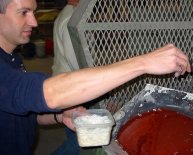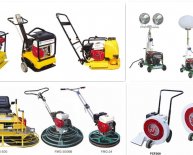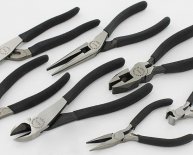
Tools for Concrete
A concrete countertop shop requires several different types of equipment layed out in different areas: woodworking tools for mold building, material storage, concrete mixing equipment, wet processing area and sealing area. Click here for an article that explains how to lay out those areas of specialty woodworking and concrete equipment.
In addition, you will need lots of small items such as rubber boots, gloves, safety glasses, buckets, etc. The list below explains all of these miscellaneous items as well as some basic materials and tools. Almost all of these are available from home centers or contractor supply stores. Visit the Shop Supplies and Equipment secton of the CCI online store for the specialty items.
(This list does not include mix ingredients (other than cement and sand) or specialty equipment such as mixers and polishers. For information about those items, see the corresponding section of the Product Guide.)
BASIC MATERIALS
- Portland cement: Ordinary (Type 1) white (preferred) and/or gray. White cement is preferred and can be the sole cement used. Make sure gray cement does not have fly ash or pozzolans blended into it. Store in a dry, dehumidified area on a pallet or off the ground. Minimum 4 sacks of each (about 376 lbs).
- Sand: Dry, fine, clean, screened silica sand with a mean particle diameter ranging from 0.3mm to 0.5mm and a maximum particle size of 1mm. Fines should be limited to a maximum of 2% passing a 0.15mm sieve. Ideally this is a #30 screen silica blasting sand. The sand should meet the following composition: Silica – 96% -100%. Loss on ignition, clay and organic matter: 0.5% maximum, each. Light tan/white colored sands are best for greatest color versatility. Minimum 500 lbs.
- Forming material: 3/4″ thick melamine coated particle board. 4’x8′ sheets. Minimum 8 sheets.
- Form release agent: Melamine does not require form release agent, but if you use fiberglass molds or steel-topped casting tables, you need form release. See the CCI online store for form release agent.
- Screws: Wood screws (or drywall type) suitable for fastening particle board. Length should be 1.25″ for 3/4″ material. Torx or square drive preferred. Straight slotted head style is not acceptable. Minimum 200 screws.
- Silicone caulking: 100% silicone in a contrasting color to the forming material. I.e. if the melamine is white, purchase black silicone caulk. Do not purchase latex, acryilc or any water-based caulk. GE Type 2 silicone works very well. Minimum 3 tubes.
- Paste wax: beeswax, carnauba wax or a similar blend of soft paste wax for wood. This is not used on the concrete but as a release for the silicone. 1 can is adequate.
- Extruded polystyrene foam insulation board: 1/2″, 1″, 1.5″ and 2 inches thick, 4 ft x 8 ft sheets. Minimum 1 sheet of each size
- Double sided tape (for carpets): Get the thin kind, not the thicker foam type. 1 roll
- Template stock: 1/8″ thick (or some thickness close to that, such as 3/16″) luan plywood. Often sold in 4’x8′ sheets. 5mm floor underlayment works but is a bit thick. Minimum 2 sheets.
SHOP ACCESSORIES
- Casting table: GFRC usually is cast in purpose-built melamine forms. However strong, flat tables or carts are still necessary to support the forms. Minimum 4′ x 8′, 1 table. Table height should be 30″-32″ off floor. Tables should be flat to within 1/16″ over 8′.
- Rolling carts: Some sturdy movable carts that can support a form weighing 300 lbs. Height should be around 24 in to 28″. The cart should have swivel wheels each capable of supporting 100 lbs. Ideal cart sizes are 24″ wide by 48″ long and 24″ x 96″ long. Minimum 2 carts of each size. Suggested design: 2×4 frame with 3/4″ plywood work top.
- Saw horses: 2 pairs capable of supporting 300 lbs.
TOOLS
- Table saw: Capable of safely cutting melamine. Do NOT buy a small portable saw. Saw must be on legs or a sturdy base. Fence must be capable of ripping 24″ wide (or wider) material. Consider a contractor or hybrid saw. Must have a good rip fence and a sharp blade suitable for melamine. A great blade is a Freud 84 tooth blade, triple chip grind made for laminate and melamine. Suggested blade: Freud Thin Kerf Double Sided Laminate/Melamine LU96R010
- Miter saw: Capable of safely cross-cutting material like melamine. A sliding compound miter saw is ideal.
- Cordless drills: For screwing together forms. A set of lithium ion cordless drill and impact driver is ideal.
- Drill bits for screws: 7/64″ is common for #2 screws. Several driver bits to match screw heads.
- Jigsaw: For curved cuts. Buy appropriate blades for melamine.
- Wood router w/ 1/2″ collet: Suggested router: Bosch 1617EVSPK or Porter-Cable 893PK.
- Flush trim pattern router bit: 1/2″ diameter shank, 2″ cutting length. Suggested: Eagle America #117-1225 ( or Freud Downshear Helix Flush Trim Bits #42-204.
- Random orbit sander: With sanding pads grits 120, 180, 220, 320, 400.
- Squares: Small framing square, speed square (Swanson style)
- Buckets – LOTS! 5 gallon buckets: 12 (minimum). 18-24 is better. 5 quart: 12 (minimum). 1 quart: 12 (minimum). 9 to 16 oz plastic drinking cups (red solo or clear plastic). 24 minimum.

















